ВУЗ: Казахская Национальная Академия Искусств им. Т. Жургенова
Категория: Книга
Дисциплина: Не указана
Добавлен: 03.02.2019
Просмотров: 17305
Скачиваний: 51
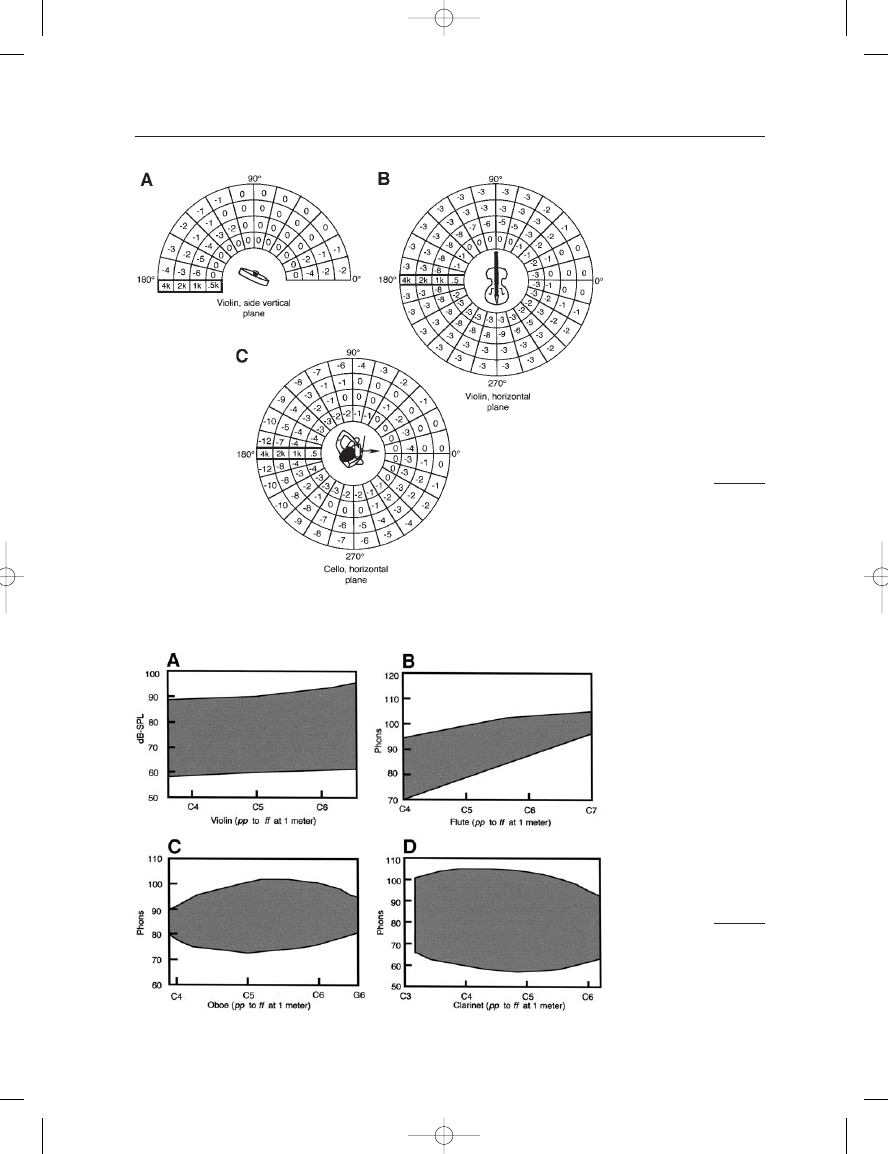
THE MICROPHONE BOOK
198
FIGURE 13–3
Directionality of string
instruments: violin in
transverse vertical plane
(A); violin in azimuthal
plane (B); cello in
horizontal plane (C).
FIGURE 13–4
Dynamic ranges versus
frequency; violin (A);
flute (B); oboe (C); clarinet
(D); trumpet (E); French
horn (F).
Earg_13.qxd 14/9/04 2:53 PM Page 198
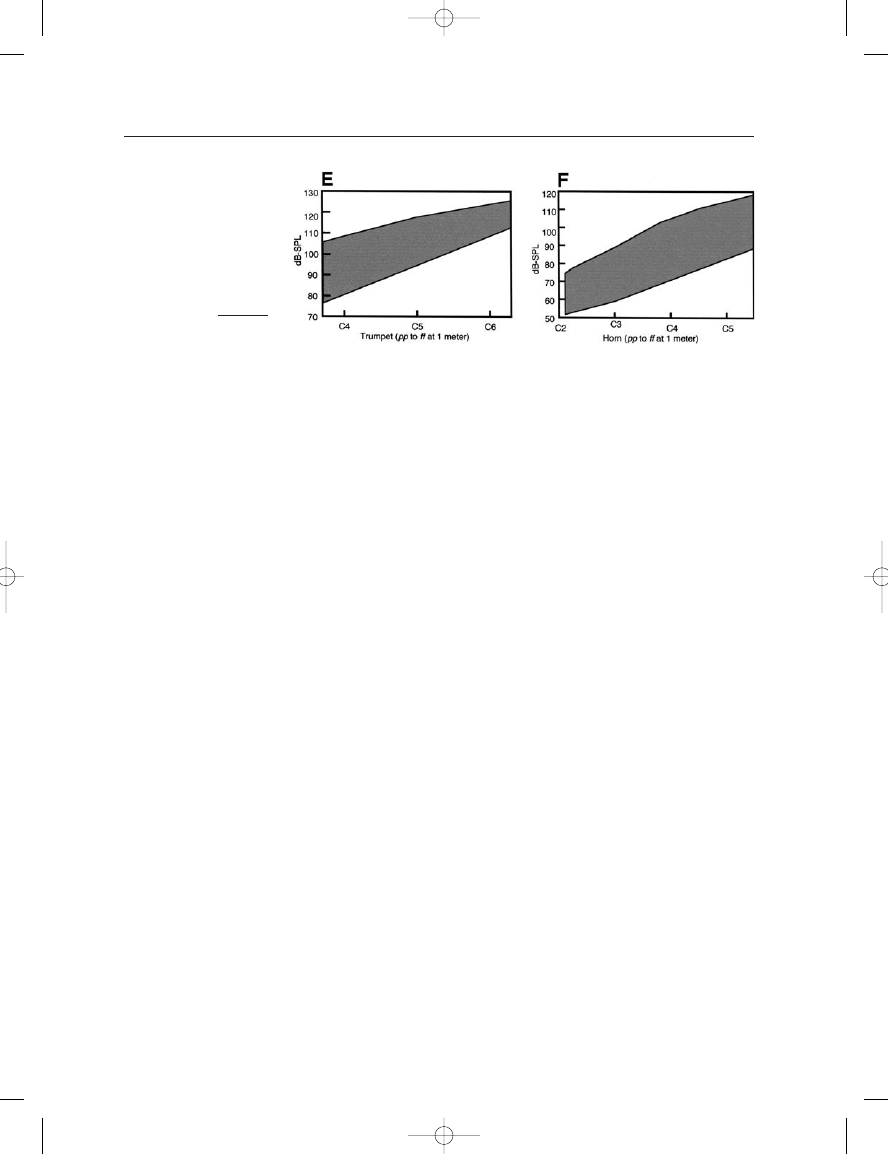
for projection in recital or concert performance spaces. Often, this means
that the piano may sound a little aggressive close in. If this is the case,
then a technician should be asked to tone down the instrument to what-
ever degree may be necessary. Normally, this requires that only the upper
three octaves may need to be adjusted.
The piano can be recorded best in recital halls of moderate rever-
beration time, as opposed to a typical concert hall. Some microphone
approaches are shown in Figure 13–5; A and B show coincident pickup
while C and D show spaced omnidirectional microphones. With spaced
microphones, it is important not to overdo the spacing, and you should
take care that the microphones be approximately equidistant from the
sounding board to ensure reasonably coherent pickup of the lower vibra-
tion modes of the sounding board. Listen to various spacings before you
commit yourself.
In most cases it would be a mistake to move much farther from the
instrument than shown in the figure, the danger being pickup of too
much reverberation. When using a coincident approach, take the time to
experiment with various microphone splay angles and pickup patterns
with the aim of achieving the proper stereo stage width.
Some producers and engineers prefer to remove the piano’s cover
and place the microphones nearly overhead. This will result in increased
low frequency response and may or may not be appropriate for the
repertoire. Proceed with caution.
If possible, a stand-by technician-tuner should be on hand during the
sessions to do touch-up tuning or take care of any mechanical noises that
may develop in the instrument. Damper pedals are often noisy and
require attention. Often, a small piece of carpet under the pedal lyre will
“tame” the noise produced by an overactive peddler.
The harpsichord creates a shower of higher harmonics and relatively
little fundamental. As such, it can sound with great clarity in the fairly
reverberant environments which are normally chosen to enhance
baroque and classical literature for the instrument. The same general
pickup approach for the piano may be used here, with a slight preference
for spaced omni microphones. The harpsichord key action may generate
13: Classical Stereo Recording Techniques and Practice
199
FIGURE 13–4
Continued.
Earg_13.qxd 14/9/04 2:53 PM Page 199
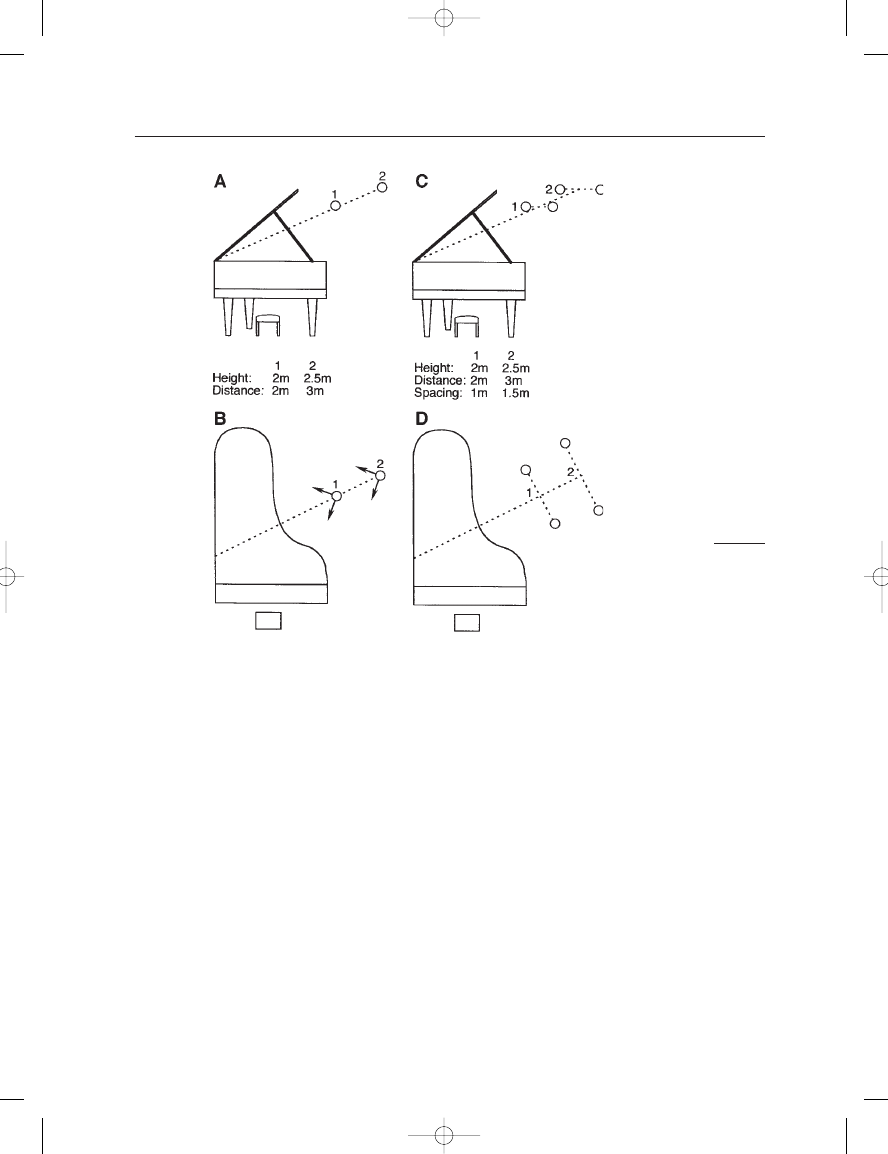
a good bit of noise, which can usually be alleviated with a 60 or 80 Hz
high pass filter.
Regarding the stereo soundstage presentation, a piano should appear
to be spread over a center portion about two-thirds the total stage width,
with reverberant cues coming from the entire stage width. (See Compact
Disc Reference 1.)
THE GUITAR AND LUTE
Again, the choice is between coincident and spaced microphones, and the
basic options are shown in Figure 13–6. With coincident pickup, watch
out for proximity effect, and be prepared to equalize it accordingly. If the
primary microphones do not pick up enough reverberation, you can use
a spaced pair of room microphones to enhance the sound. Do this only
if the room is quiet enough; otherwise, consider using a high quality digi-
tal reverberation generator with appropriate room parameters pro-
grammed into it. (See Compact Disc Reference 2.)
THE MICROPHONE BOOK
200
FIGURE 13–5
Recording the piano;
using coincident or
near-coincident microphones
(A and B); using spaced
microphones (C and D).
Earg_13.qxd 14/9/04 2:53 PM Page 200
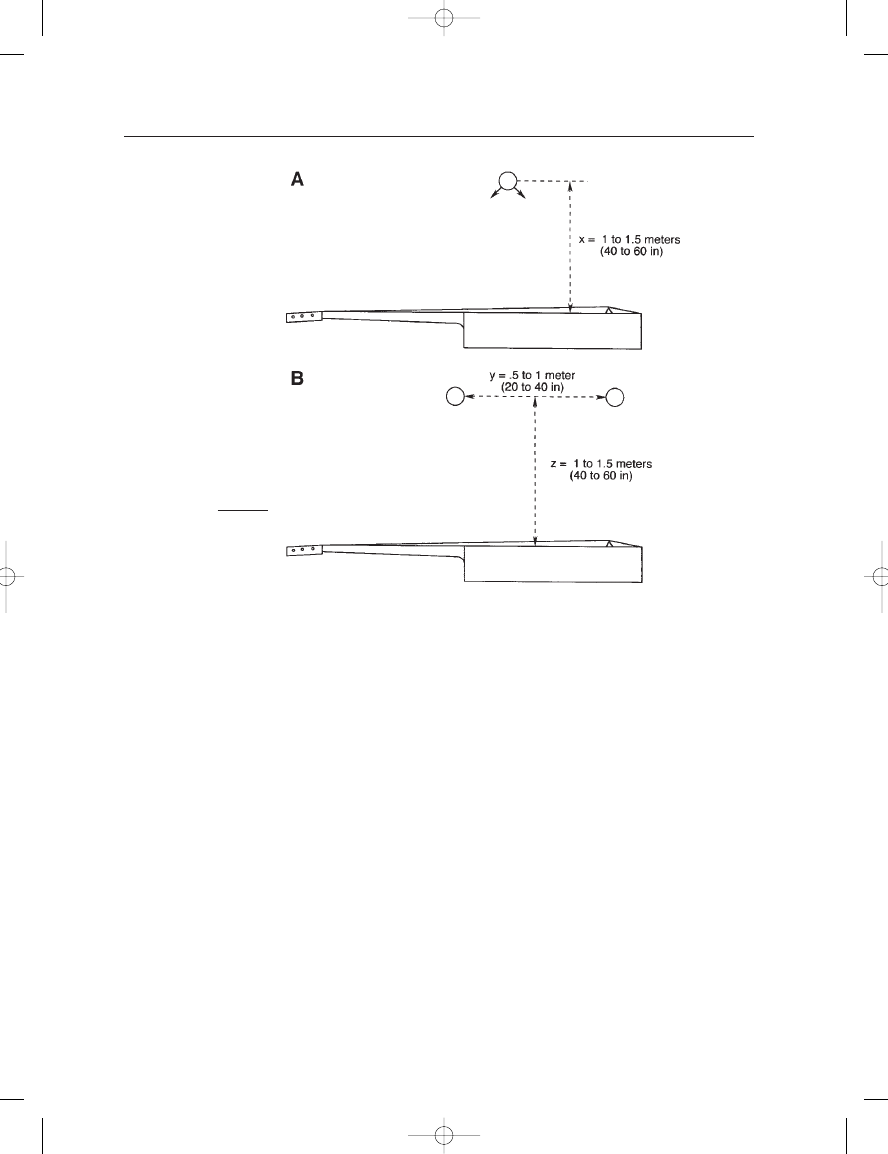
THE ORGAN
Of all instruments, the organ is the only one that does not “travel.”
Unless it is a small portative instrument which is often used for baroque
music accompaniment, the organ is permanently built into a large space
and voiced for that space. No two organs are even remotely alike, and
the choice of venue is equally important as the choice of performer and
literature. The organ is usually heard at a large distance, and specific
directional effects from the instrument are the exception. The listener
thus hears the organ and its environment as an entity, rather than as an
instrument independent of its surroundings.
In many cases a single pair of omnidirectional microphones will suf-
fice to pick up the instrument at a distance up to 6 or 10 m (20 to 33 ft).
If the instrument’s keyboard divisions are laid out horizontally, then a
coincident pair can be used to delineate lateral directionality. Usually the
instrument is arrayed vertically, and lateral imaging will be lost as such.
In some cases an instrument installed in the rear gallery of a church
consists of a main set of pipework along with a rückpositiv division sus-
pended on the gallery railing. In this case the fore-aft imaging aspects
will be readily apparent in the recording. A suggested starting point is
shown in Figure 13–7.
13: Classical Stereo Recording Techniques and Practice
201
FIGURE 13–6
Recording the guitar: using
coincident or near-coincident
microphones (A); using
spaced microphones (B).
Earg_13.qxd 14/9/04 2:53 PM Page 201
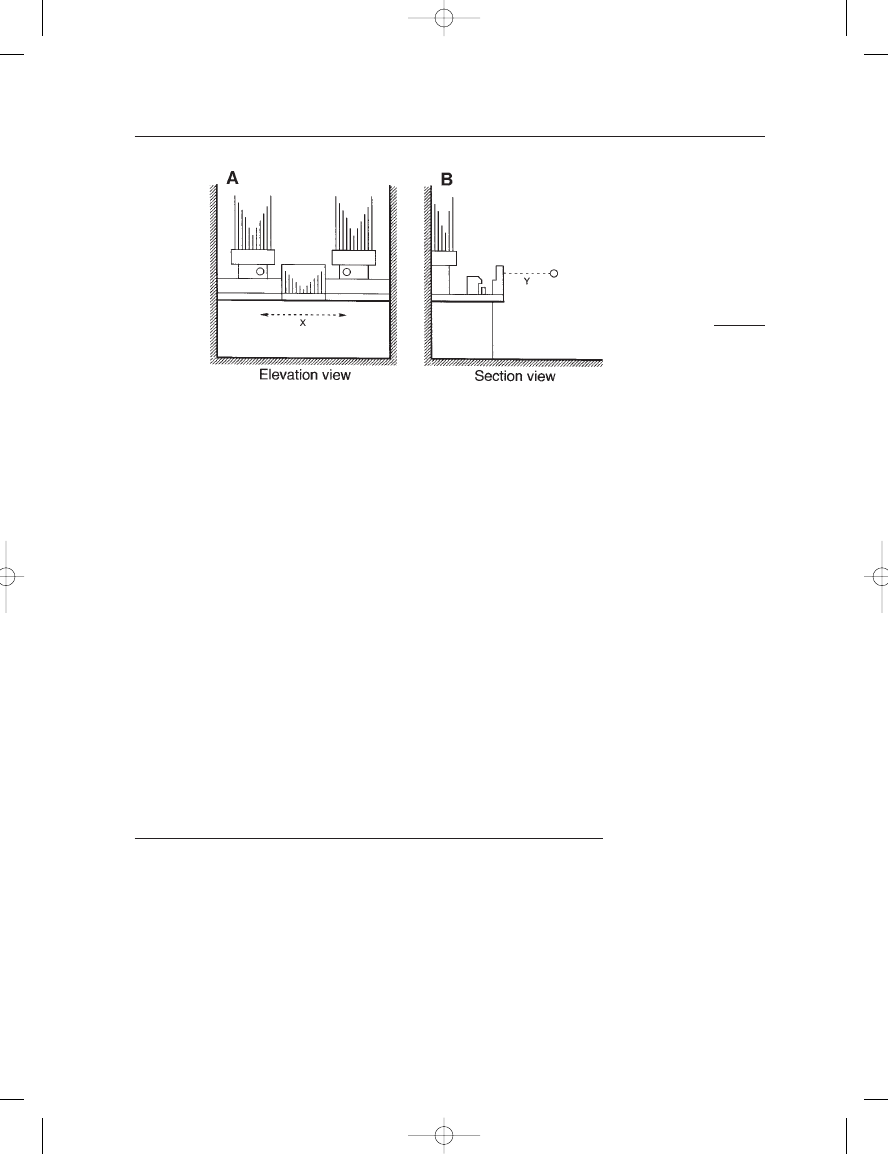
In many European cathedrals the organ is located very high in the
rear gallery, as much as 15–20 m (50–65 ft) above the floor of the nave.
There are no microphone stands tall enough to put the microphones
where they need to be, and the normal approach is to hang microphones
from the ceiling or from lines suspended from side to side at the height
of the triforium gallery. Such preparations take time and can result in
microphone cable runs up to 100 or 150 m (330 to 450 ft).
If the engineer is required to work from the floor it may be useful to
experiment with both omnidirectional microphones on high stands,
along with a widely spaced pair of line microphones aimed at the instru-
ment. These will provide added directionality at high frequencies and
may help to clarify the texture of the instrument.
A secondary pair of microphones in the middle of the venue may
flesh out the reverberant signature of the space, should that be needed.
These microphones may be rolled off at low frequencies to minimize LF
room rumble and to maintain clarity. In some spaces that are large but
not sufficiently reverberant, an artificial reverberation generator may be
useful. However, not many reverberators can duplicate accurately the
long reverberation time associated with large spaces. (See Compact Disc
Reference 3.)
RECORDING CHAMBER MUSIC
Chamber music may be roughly defined as music written for groups
numbering from two to perhaps twelve performers, with one performer
on each part and normally performing without a conductor. For smaller
chamber groups there are basically two choices for the recording engi-
neer: to record the group in a concert setting as they would normally be
seated on-stage; or to record them in a studio setting arrayed in an arc,
or even facing each other. There are advantages to both approaches.
The concert setup will be familiar to the players and as such may be
preferred at the outset. Conventional microphone placement would call
THE MICROPHONE BOOK
202
FIGURE 13–7
Recording the organ:
elevation view (A); section
view (B).
Earg_13.qxd 14/9/04 2:53 PM Page 202